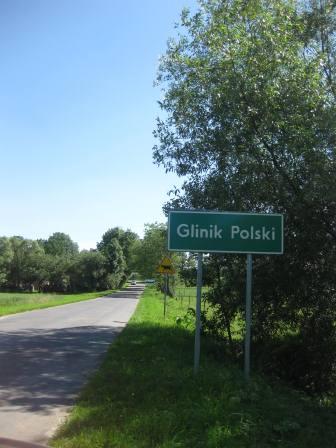
Glinik Polski, Tarnowiec, Jaslo, Poland
(c) 2012 barefoot photos
This day would prove to be my most exciting day in Poland, though I didn’t figure that when we began since we’d decided to focus on our thorniest problem, the Garbaczyks.
I still did not know the village of origin and did not believe we’d be able to figure it out in such a short period of time.
I hadn’t counted on Iwona’s nose for genealogy, however. After a short rest in our rooms and a review of immigration records found online, we set our sights the next morning on a village called Glinik Polski.This was our educated guess. Poland has a lot of areas of clay soil. There were plenty more Gliniks — all over Poland.

Leszny church yard
(c) 2012 barefoot photos
Family lore stated that Josephine Garbaczyk met Big Joe Moraniec as a child. Supposedly, they attended grade school and were fell in love at a young age. That meant that the Glinik Josephine was from, would have to be near Bobrowa, Debica, the village the Moraniecs are from. I had, however, searched the records fairly extensively, and not found the Garbaczyks. So when Iwona suggested Glinik Polski, 6 miles from Jaslo, I was skeptical. That was too far. And I believed the story that had been passed down. It was even recorded in a family history!
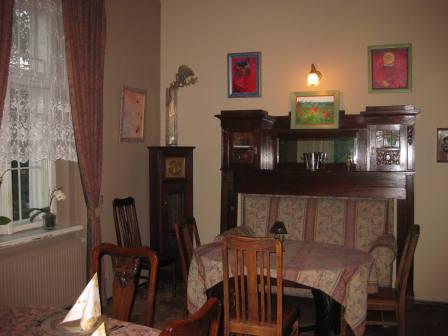
Debica, Poland
(c) 2012 barefoot photos
We enjoyed a full breakfast in the Villa Wiluszowka and made sandwiches from the bread and cheese to carry with us for lunch. They turned out to be perfect meals in the middle of intense researching! A couple of yogurts set out for our breakfast grew warm and juicy in our lunch bag. We never went hungry after enjoying our first meal of the day in a Polish hotel. It’s very unlike the often skimpy provisions set out at American chains.
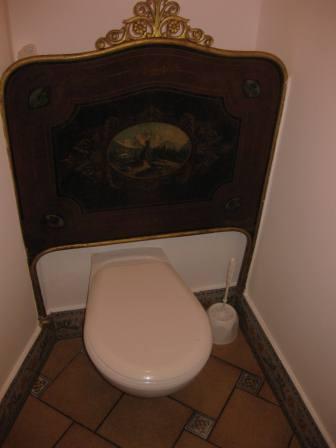
Debica, Poland
(c) 2012 barefoot photos
Glinik Polski is an hour south of Debica, quite a bit further away than what we had originally bargained for Iwona driving, but we amicably agreed upon terms. Working with Iwona was a joy. I learned much about genealogy during the road conversations on our trips.
Whispering greetings to cousin Ann’s Guziec ancestors as we drove through Pilsno, my excitement mounted coming upon another place that I knew of only from hearsay and maps.
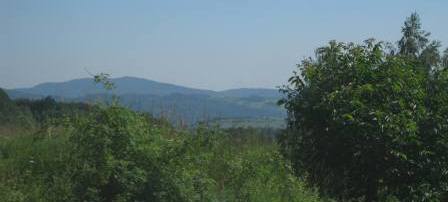
Jaslo, Poland
(c) 2012 barefoot photos
I was surprised how much the landscape changed as we drove south from Debica. We were soon in the middle of gentle mountains! I immediately fell in love with this gorgeous place. We’d pass goats, and very few sheep here, another sign of our rise in elevation.
As we passed through Jaslo (6 miles from Glinik Polski and 30 miles from Debica), we learned that the area was well known for its petrol business, which provided jobs in the oil fields for many peasants.
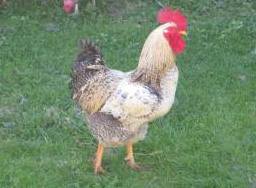
Glinik Polski, Jaslo, Poland
(c) 2012 barefoot photos
Farming though, remains the major occupation. And as we saw elsewhere in Poland, hand tools are still commonly used, often beside trucks and tractors. We passed a gentleman cutting hay with a scythe.
That was of particular interest because when we owned land in Arkwright NY, we tried cutting our grass with hand tools. Such hard work it was! Mechanization has erased the memories of a daily physical grind for most of us.
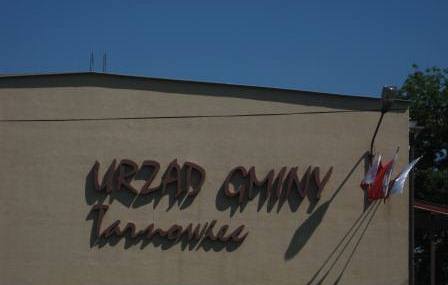
Tarnowiec, Jaslo, Poland
(c) 2012 barefoot photos
First stop: Tarnowiec Town Office, located further up the hill from the church and cemetery. Our ancestors would have traveled to Tarnowiec often for church events, festivals, official functions. And I’m guessing they walked!
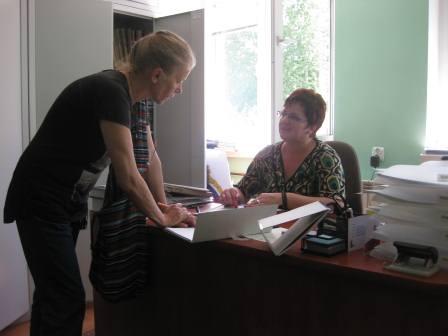
Tarnowiec, Jaslo, Poland
(c) 2012 barefoot photos
We pored through what records we could. Well, to be honest, Iwona and a clerk pored. Rebecca and I listened and took notes after Iwona translated info.for us.One of the municipal office clerks was from Glinik Polski. Lady Luck was traveling with us. We learned that Garbacik (yes, that’s the way the name is spelled in Poland!) descendents still lived/farmed Josephine G.’s family home. And we learned that Biedrons remained in Glinik Polski at least until the 1930s.
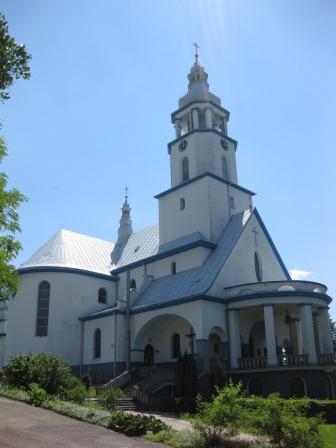
Tarnowiec, Jaslo, Poland
(c) 2012 barefoot photos
Second stop: Tarnowiec parish, St. Joseph the Worker. We took our time, snapping photos as we strolled the walkway to the rectory office. I begged a short stop at the parish store enroute. Gift shop! Yes, I knew that something from Glinik Polski would be wonderful gifts. I found a delightful painted wooden Madonna and a board book, in Polish, about farm animals. With the pictures, I can actually translate it. I gave the Madonna to the woman I sublet my yoga studio space from.
After quite a bit of finagling, we were allowed to check out the old parish records. Filled with disappointment

Tarnowiec, Jaslo, Poland
(c) 2012 barefoot photos
at not finding the book for Glinik Polski, the three of us turned to leave. The priest, however, said “Wait a minute” and in a second he pulled one more book off the shelf and it was the one we needed.

St. Joseph the Worker parish
Tarnowiec, Jaslo, Poland
(c) 2012 barefoot photos
Trembling, we opened it carefully and began to read the names. Relatives were on the very first page! With Iwona’s help at translating, Rebecca and I quickly got the hang of how to read the records. The priest came back in the room, and graciously offered to let us look while he had his lunch. We couldn’t believe our good fortune.
Without further ado, we decided to photograph every page of the book. We nearly finished when Father returned as said he had a meeting and we had to finish up. We gave a donation to the parish, thanked him profusely and went to the cemetery to see if we could find Garbaczyks and Biedrons we now knew had lived here for generations.
Third stop: The old parish cemetery behind St. Joseph’s. Iwona would check back on some more records at the Town office, while Rebecca and I took different corners of the graveyard to search for relatives.It was early afternoon and the sun was blazing hot. Of course, we did not have sunscreen with us, nor did we have hats, or water. And this cemetery had darn little shade. Within the hour, we were both close to heat exhaustion. When Iwona joined us, she thankfully, sped us through the rest of the cemetery.

Tarnowiec, Jaslo, Poland
(c) 2012 barefoot photos
Wandering through a Polish graveyard is interesting because of the way the graves are packed so densely that there is hardly any space to walk.
Also, visiting graves is a bigger deal in Poland and there were not only beautiful flowers planted on top of graves as well as in nooks and crannies all over; there were bouquets of plastic flowers and glass lanterns, some still lit, others long since fallen over and broken. Since I was wearing sandals, I had to tiptoe around the broken glass laying every which way.
Fourth stop: Łężyny
St. Nicholas the Bishop parish in Łężyny would have been the church Jozefa and her family belonged at the time she emigrated to the US. The records of her birth as well as of Teresa Biedron’s birth would be stored there.
Note: the records stored in the Glinik Polski parish began in 1884. Josephine was born about 1876. Unfortunately, we were unable to view the records, but we did look around the gorgeous old wooden church.
Though not as famous as the shrine to the Virgin Mary at the Tarnowiec church, this was my favorite ancestral church building. Hard to believe it was hundreds of years old. And wooden! The way the steeple was built, with nearly an onion dome, left me to believe a Ukranian influence. Not surprising, considering how close we were to the Ukraine. The Ruthenian churches are called uniate parishes.
Fifth stop: Garbaciks! The village numbers were helter skelter, so we knew we were in luck as far as finding the old homestead of Josephine Garbacik.Outside of the church, there was a shrine of what Rebecca termed, Bummed Out Jesus, that I also loved. These were common all over Poland. rather than hanging on a cross, Christ sits in front of the cross, hanging his head in his hands. He looks depressed, as if he knows what lay ahead for him.
We drove along a long dirt drive that was sort of parallel to the main road through Glinik Polski. Suddenly, it seemed the drive simply ended in a field.
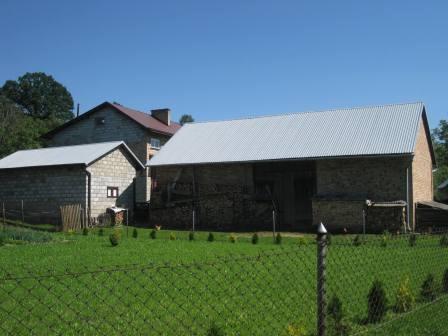
Glinik Polski, Tarnowiec, Jaslo, Poland
(c) 2012 barefoot photos
There was a house set back from the road, but we couldn’t read any number on it. The day was blazing hot, and a woman was playing with little boy in a wading pool in the front yard.
Next door, a brick barn stood with chickens roaming around. We were sitting in the hot sticky vehicle trying to figure out what to do when a car pulled up behind us and parked. For some reason, I

Glinik Polski
(c) 2012 barefoot photos
was nervous and thought we’d be chased away. Iwona got out and met a gentleman who walked out of the other car. Rebecca and I could see them talking.
Curiosity and the heat got the best of us, and we stepped outside too. Iwona motioned me over, and said, “Carolyn meet your cousin, Jan.” I smiled and shook his hand. I’m not sure who was the more stunned. Here we were, unknown relatives showing up unannounced from America. Jan couldn’t have been more gracious!
He invited us in and introduced us to his family, with Iwona acting as translator. His mom soon joined us and when she realized who I was, we both teared up and shared a long hug.

Glinik Polski, Jaslo, Poland
(c) 2012 barefoot photos
Meeting Czeslawa was an incredible moment because Rebecca and I share complete mtDNA with her. She is in the same maternal DNA line. I believe that we recognized we were kin – at a cellular level – the moment we saw each other. This is the first time that I have experienced this level of familiarity with someone beyond first a first cousin. I was again stunned, this time by an emotional, rather than an intellectual (as it usually is when encountering other cousins) jolt that surged through me at that meeting.
Sitting in the airy living room, she told us family stories and filled us in on more

Glinik Polski, Jaslo, Poland
(c) 2012 barefoot photos
family history as we sipped delicious tea her granddaughter made. As I looked at Czeslawa, I realized where my square square jaw comes from– the Glinik Polski DNA, of course. Iwona took a photo of all of us in front of the house. We said our goodbyes to this delightful family, happy to know that we were related to such great folks.

(c) barefoot photos
Jan then led us to another cousin’s home down the road. More chickens wandering about a lovely farm yard. This turned out to be an elderly couple whose daughter is a lawyer in Warsaw. I wondered if Sue would ever get to meet her cousin.
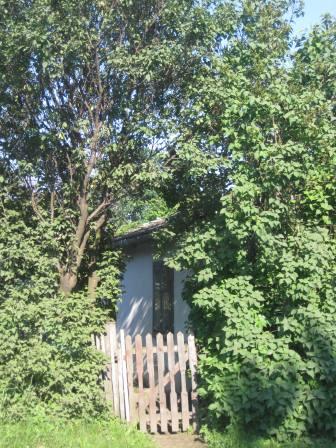
Debica, Poland
(c) 2012 barefoot photos
Driving back through the verdant countryside, I had much to ponder.
No time for lolling though, a meeting had been arranged with the parish office in Nagoszyn for 7 PM. I’ll cover that in tomorrow’s post.
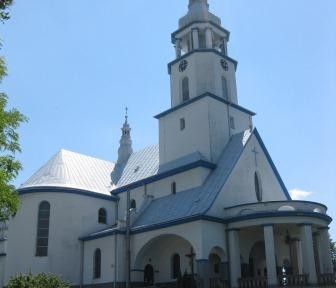
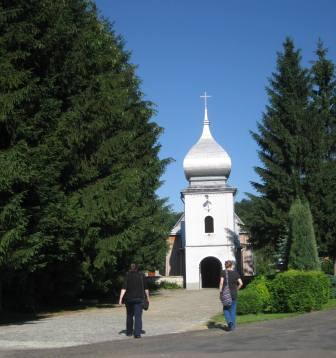
5 responses to “The Moraniec and Garbacik homeland, Day Two”
Curious as to the reference for the tag Kapala that you use on this page? Can you provide further information?
Not sure what you are looking for, greg, other than what I said in this post. You can email me with private info: carolyngrady at gmail.com.
This is very interesting. I have been researching my family from the Hazelton, PA side. I knew that we were descended from tanners, but my grandfather also said that the family was originally of Jewish descent, and that also caused a split in the relations.
Rick, that is VERY interesting,indeed. Do you have any other info. about the split? Do you have Biedrons anywhere in the lineage? If you wouldn’t mind, would you send me how you descend and your ancestors?
Has anyone on your side been DNA tested? That would help us to sort through where the Garbaciks originated, etc.
I look forward to hearing from you again and sharing our combined expertise.
Thanks for posting!
I’m curious to know if the Municipal Office and St. Joseph the Worker RC Church had records for the village of Wrocanka. My grandmother’s family name is Radon. She is related to the Wojcik and Uram families. Did you come across any of these names in the official books? Since I’m unable to make a trip, such as yours. Do you have any contact information for both institutions?